Raising Water Consciousness through
World’s Biggest Photo Exhibition and
Largest collection of Photo Stories on Water
Photo Stories | Water and LivelihoodA story based on the theme of World Water Day 2018
Khadin: A Nature-Based Solution for Water for Agriculture in the Great Indian Desert
Nandita Singh and Om Prakash Singh
15 October, 2018
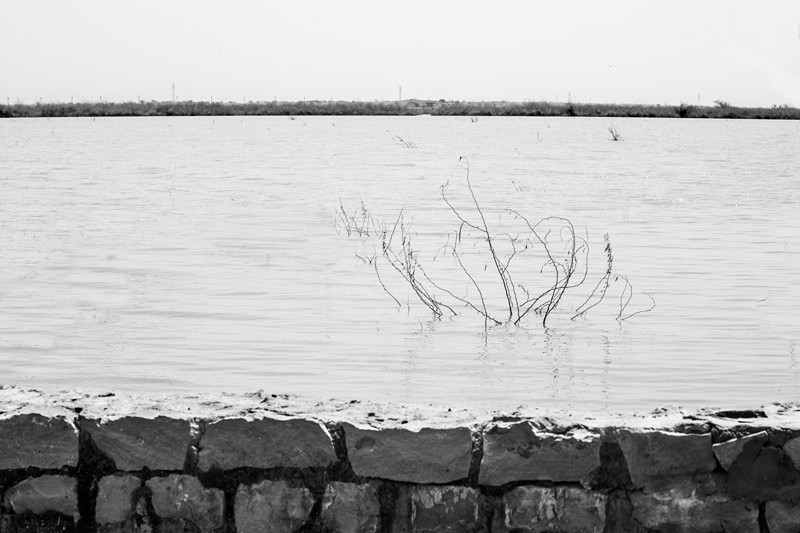
Water is a basic prerequisite for agriculture but securing water can be a great challenge in desert ecosystems. The Great Indian Desert, also known as 'Thar Desert', is spread over an area of more than 120,000 sq.km. in northwestern India, about 60% of which lies in Rajasthan where the major districts are Jaisalmer, Barmer, Bikaner and Jodhpur. Low erratic rainfall, dominantly dry sandy soil terrain with widespread sand dunes, absence or disorganized natural drainage, very deep and saline ground waters, and very high evaporative conditions makes the region inhospitable and unsuitable for agriculture. Occurrence of drought is commonplace with folklore reckoning four out of every 10 years as drought years. It is remarkable that rural communities have thrived in such a harsh ecosystem for centuries, with dependence on agriculture as a key livelihood strategy. This has been made possible through adoption of the nature-based solution of 'khadin' that fulfils not only the needs of water but also good quality soil for carrying on productive agriculture. Khadin-based agriculture is indeed one of the secrets that makes the Thar Desert of Rajasthan the most densely populated desert of the world, enabling over 40% of the State's population to reside there. The khadin system is essentially a 'runoff' agricultural system based on the principles of rainwater harvesting from a catchment; diverting and collecting the runoff on the farm land, inundating the land during monsoon (kharif) cropping season and producing crops on this land during the winter (rabi) season using the stored moisture. The fine sediments brought along with the runoff increasingly enhance khadin soil fertility year after year. The tradition of khadin-based farming in the Thar Desert is contended to be older than 3,000 years, but it is known to be substantially developed by the Paliwal Brahmins in Jaisalmer district in the 13th century who possessed knowledge and skills about the science of khadin-making. They connected several local catchments into a well-knit system of khadins and were thus able to produce crops even during the low rainfall years. This photo story aims to make a presentation of this inspiring tradition of khadin as a nature-based system for water for agriculture that continues to bring water and food security and thereby prosperity to a substantial segment of the population residing in the arid desert region of Rajasthan. The focus of the presentation is on Jaisalmer district, which constitutes the major part (32%) of the Great Indian Desert and where khadins have served as a nature-based system enabling sustainable agriculture through centuries. According to an earlier estimate, there exist as many as 500 big and small khadins covering an area of 28,400 ha in the district. However, in recent years, many of the older dilapidated communal khadins have been revived and several smaller new ones been developed, increasing their number to about 800. The title photo depicts Derasar – a large 'communal' khadin extending over an area of 75 hectares, jointly owned by three villages – Raghwa, Seuwa and Joga in Sam block, Jaisalmer district.
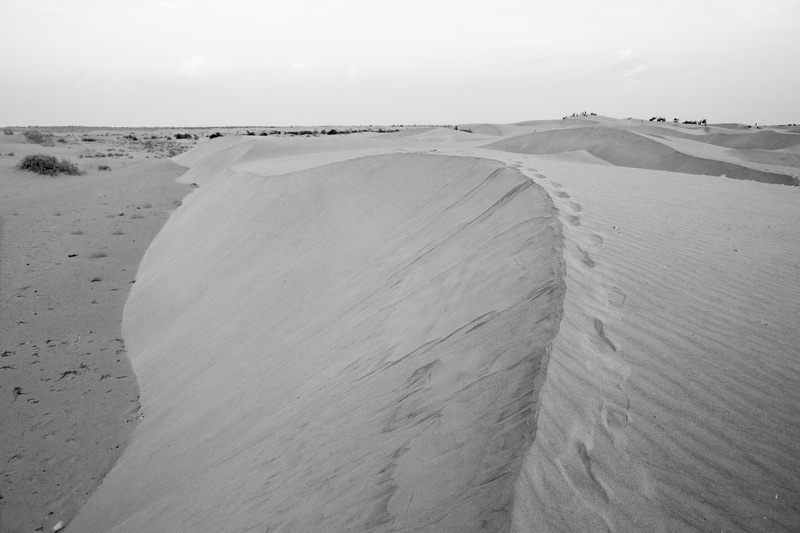
The arid landscape of the Great Indian Desert in Jaisalmer district
The landscape of Jaisalmer – the largest district of Rajasthan - is primarily sandy, looking like a sea of sand dunes as shown in the above photo. The biggest sand dunes are found in Sam block, where these are mostly stabilized and look like sandy hills. At places, however, the soil is stony containing rocky ridges and hard undulating plains. There exist no perennial rivers or natural lakes in the district and the water table is very low, generally deeper than 40 m. The climate is arid characterized by extreme dryness of air, large extremes of temperature varying between below freezing point in the winters to above 45°C in the summers, and erratic meagre annual rainfall which is as little as 100 mm on the western fringes. Due to the prevailing arid conditions, vegetation is very scarce and constituted of primarily tropical thorn forest, the forested area being only 1.17%. It is in this arid uncongenial environment that the khadin system has wielded magic, enabling productive agriculture for sustaining rural communities through generations.
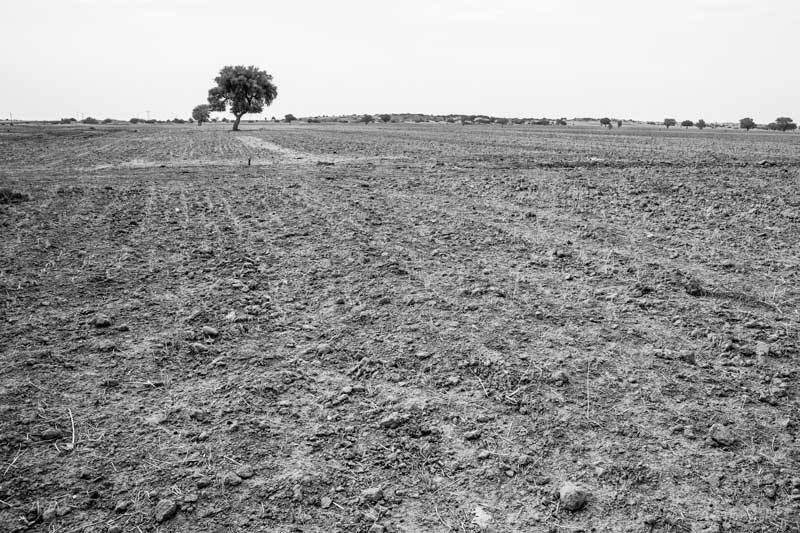
Fallow agricultural fields inside Masurdi Khadin
Khadin represents a unique traditional nature-based system of cultivation in the Great Indian Desert where rainwater harvesting during the monsoon season enables moisture conservation in the soil, which is later utilized for growing winter (rabi) crops. Two essential land components serve as the building blocks of the khadin system: i) suitable high land surface, comprised of compact gravelly or rocky areas with high runoff potential which can serve as the catchment (locally called 'aagor'), and ii) gently sloping saucer-shaped lowlying land in the proximity which receives the runoff to get inundated and where soils are deep enough for crop production in the rabi season (locally called the 'khadin'). The size of khadins can vary from few to hundreds of hectares and their ownership and management may be communal or individual. Generally, the old traditional khadins are large and communal in nature and are named after the nearby village. Masurdi khadin, shown in the above photo, is one of the biggest khadins in Jaisalmer district located near Masurdi village. According to local farmers, this about 400 years old communal khadin is spread over an area of approximately 300 hectares and shared by more than ten villages.
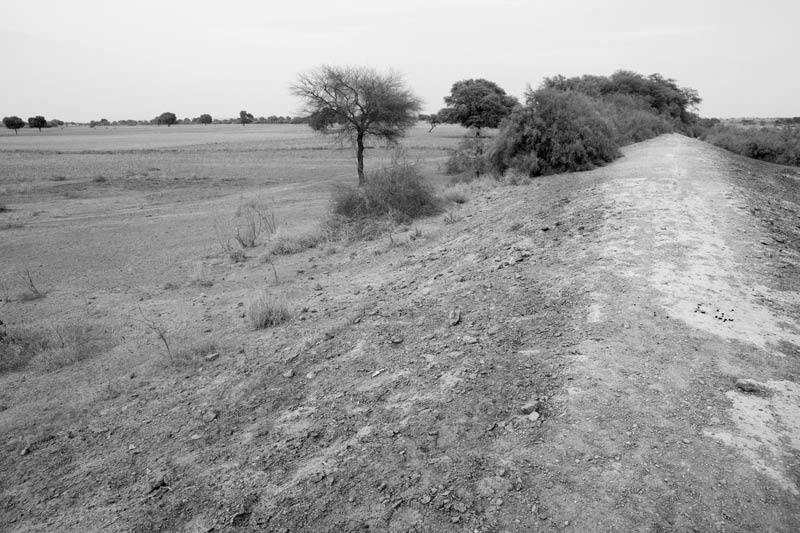
The embankment of Masurdi Khadin
The water that comes as runoff from the catchment into the khadin is impounded with the help of an embankment or bund erected at the lower end of the plain. It is commonly called 'baandh' or 'paal' and is often crescent-shaped, extending from east to west. This shape enhances the life of the embankment by easing hydrostatic pressure on the wall, while the direction of the embankment helps trap the sand carried along with winds during the dry season which blow from south towards north. The sand so trapped helps strengthen the embankment over the years naturally, making it higher and more robust with every passing year. A spillway (locally called 'chaadar') is provided at this end to allow overflow of excess of the impounded water. Khadin embankments can be earthen or sometimes even cemented. Earthen bunds are often afforested to impart strength. The embankment of Masurdi Khadin is earthen as shown in the photo above.
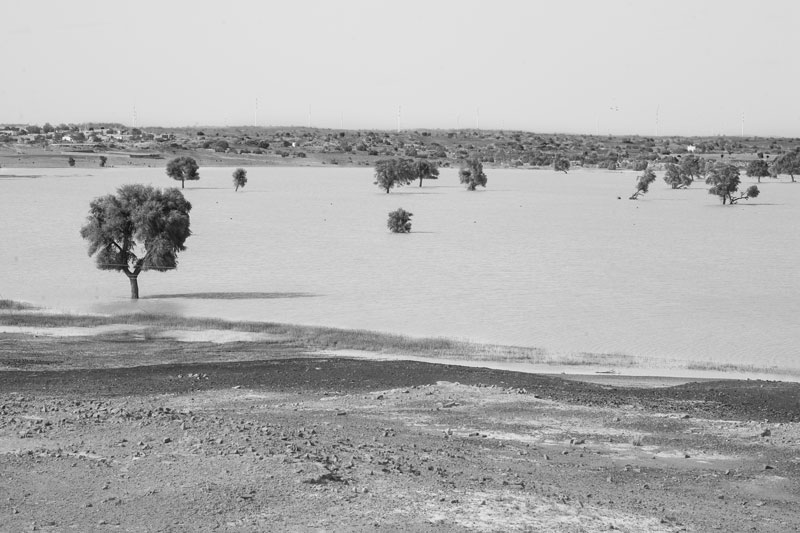
Masurdi Khadin inundated with runoff received from its catchment
Rainfall in Jaisalmer district is generally received during the last week of July and the month of August, during which khadins get inundated, as shown in the above photo. According to Chatar Singh, the Water Wizard of Thar Desert who has revived several khadins in the parched Ramgarh area of Jaisalmer district, a rainfall of 50 mm or more is good enough to inundate the local khadins. The runoff collected in the khadin infiltrates into the subsoil, creating an artificial perched water table which later supplies moisture to the roots of the crops grown in the khadin. An essential land component that enables the khadins to hold the runoff is the presence of an impervious layer below the soil in the receiving fields. Many areas in Jaisalmer district contain a layer of 'fuller's earth' (locally called 'multani mitti'), while some others have a layer of fuller's earth mixed with gravel (locally called 'muld'). The depth of this layer often varies from 1.5 - 5 m in the district and enables creation of a shallow 'perched' aquifer in the sub-soil. If the depth of the fuller's earth is more than 2 m, it is also possible to dig shallow wells (beris) near the khadins, which supply drinking water round the year. For maximizing the quantum of harvested runoff, khadins are connected to large catchments, with a ratio of 1:15 or more. The catchment of Masurdi Khadin is said to be very large and it is primarily fed by the Masurdi river- an ephemeral branch from the monsoon-fed Kak river which receives most of the local run-off.
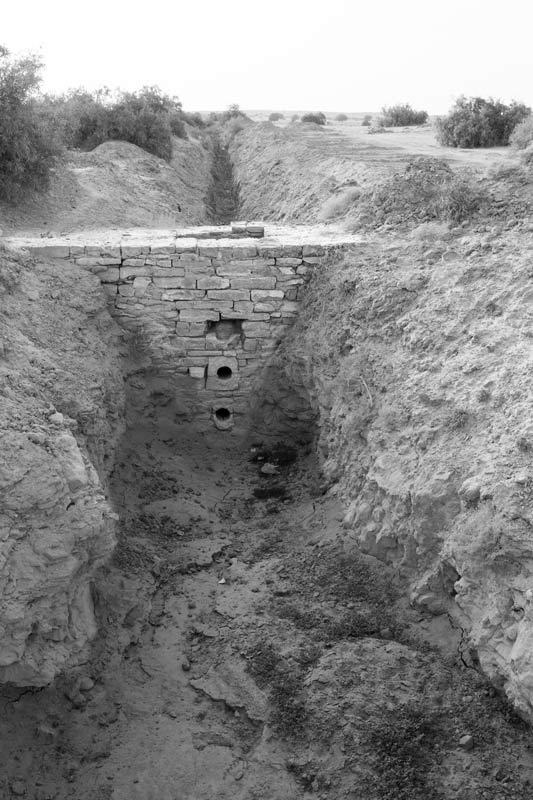
An outlet for draining out the impounded water from Masurdi Khadin
Khadins often exist in a series, with the overflow from an upstream khadin feeding another one downstream, so that no drop of the precious rainwater is lost. A khadin is allowed to remain inundated during whole of kharif season. Gradually over a period of time, the water level depletes due to percolation, seepage outside the embankment to downstream and evaporation. The water that remains above the ground is finally drained out towards the end of September, after which the fields are prepared for cultivation of rabi crops. An outlet (locally called 'naala') is provided in the embankment, as shown in the above photo, to enable draining out of the remaining impounded water before the start of rabi season.
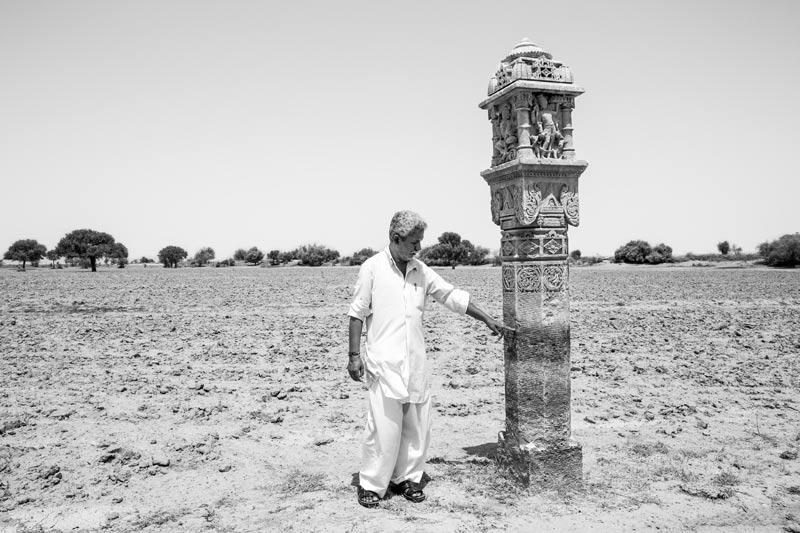
A goedhan in Derasar Khadin used for measuring the water level during inundation
Many khadins possess a pillar called 'goedhan' which helps measure the level of inundation. This can help the farmers decide upon the crops and estimate the possible yield during the rabi season. For example, too little water may lead to a decision of growing crops with very low water intake, such as gram or taramira, or even leaving the fields fallow for the season, since there won't be high moisture conservation. A water depth of 60-90 cm or more is considered good enough for cropping to take place.
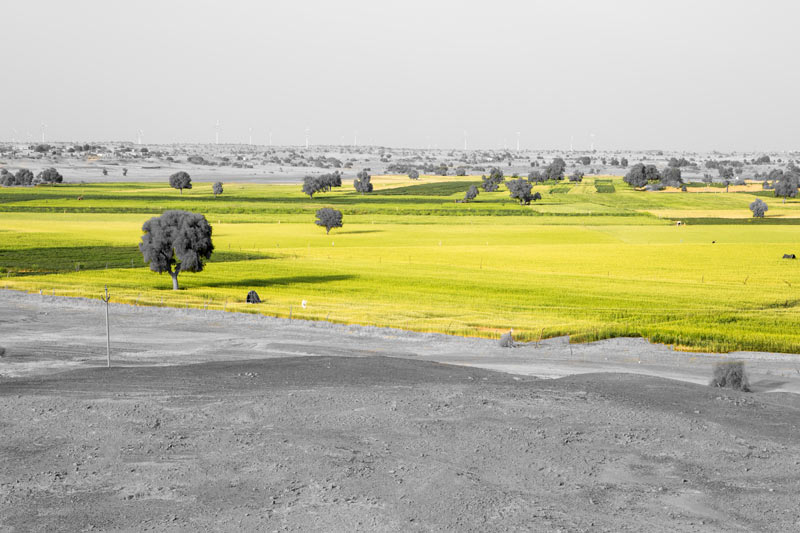
Masurdi Khadin with standing rabi crops
After the period of inundation, the khadin fields are prepared for sowing of rabi crops, primarily wheat (Triticum aestivum), mustard (Brassica nigra), gram (Cicer arietinum) and taramira (Eruca sativa). A special process is adopted to prepare the fields so as to enable moisture-based cropping. The fields are first allowed to dry up for about a month, the test being a dried top soil layer of about one-inch thickness. Thereafter the fields are ploughed 3-4 times, allowing for drying up in between and then repeatedly leveled. Traditionally ploughs drawn by camel or oxen were used, but in present times tractors are also used. Repeated ploughing brings up the wet soil layers to the top and exposure for 1-2 days helps drying up of this soil layer. This soil consists of fine alluvial particles and coarser soil particles. As the soil dries up, the two kinds of particles separate, and when a leveler is used, the finer alluvial particles get dusted down and end up filling gaps between the coarser particles. As a result, at the end of the process, all soil pores are filled and the moisture available in the lower soil layers gets sealed inside. Towards the end of October crops are sown and during the entire cropping cycle, the moisture sealed in the inner soil layers fulfill the water needs of the growing crops. Fields in Masurdi Khadin with more than 100 days old standing crops of mustard, gram and wheat are shown in the photo above.
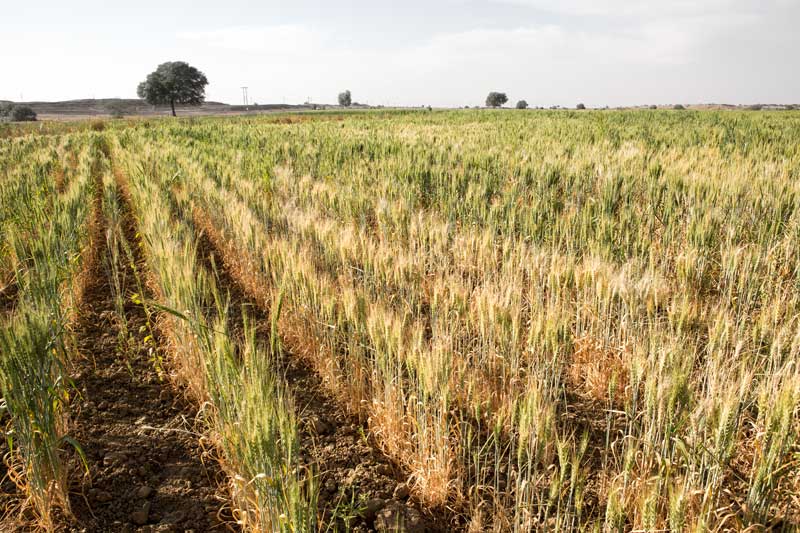
Wheat crop in Masurdi Khadin
Wheat has been the traditionally grown crop in khadin fields, which is part of the local diet. In present times, crop rotation is generally followed, but the crop for sowing may be selected on the basis of the quantum of rainfall received. If there have been 2-3 good spells of rain where the first one was at the least about 50 mm, wheat can be sown. In addition, wheat is also the preferred crop where the khadin soil is more fine-textured. Wheat crop takes about 130 days to mature and the crop is raised without the use of any fertilizer. Also, the use of pesticide is rare, being applied only in case of serious disease outbreaks. No external irrigation is applied either, whether from canal or groundwater. However, a winter rain of 5-10 mm can help improve the yield. In general, the average yield of wheat is 20-30 quintals per hectare. The wheat produced in the khadins is said to have a special flavor and therefore fetches thrice the price in the market. However, it is primarily retained for domestic consumption and seeding. It is mostly stocked at home to tide over food crisis during the drought years and seldom sold in the market.
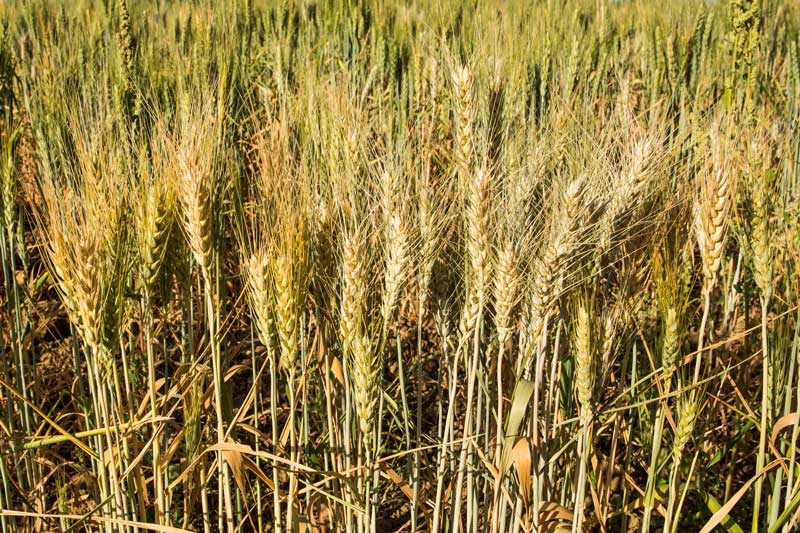
Grain heads in ripening wheat crop in Masurdi Khadin
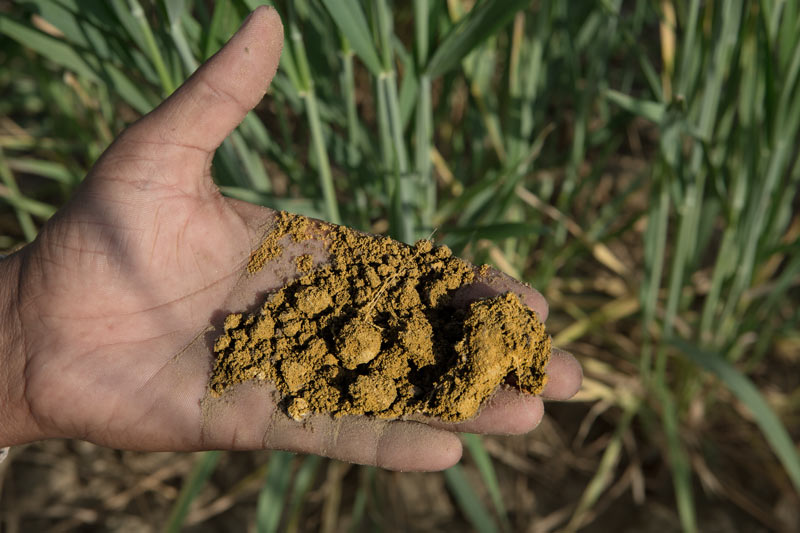
Soil quality and moisture in wheat fields of Masurdi Khadin
The khadin soil differ significantly from the ordinary desert soil around. It is commonly medium to fine textured, very deep, with sandy loam to loam at surface; and loam, clay loam and silty clay loam in the subsurface. These soils are formed from the sediments brought down annually from the local catchments upland and are free from salinity. They are more fertile and the water holding capacity often ranges from 200-250 mm /meter depth. The moisture level remains considerable even 3-4 months after the runoff is drained out, and farming is initiated. Further, since these soils remain moist for longer period in a year, there exist favorable conditions for chemical weathering of soil minerals as also vigorous microbial activities to form humus of the organic matter. Thus, these soils are richer in most of the available mineral nutrients than other desert soils and always contain relatively high organic matter or humus. The above photo presents a glimpse of the khadin soil in a wheat field at about 110 days in the cropping cycle which still retains considerable moisture.
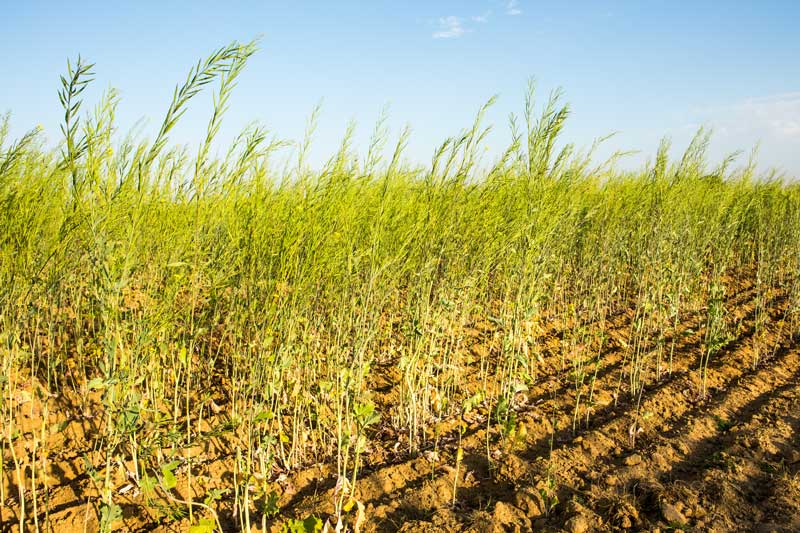
Mustard crop in Masurdi Khadin
Mustard and gram have been added as khadin crops only over the last 15-20 years. These crops are primarily grown as cash crops and fetch good market price. Mustard is commonly sown during those years when the monsoon rain is lesser, with just 1-2 spells of which a first heavier spell is able to inundate the khadins substantially. The water requirement of mustard is much lesser compared to wheat. In 2017, the monsoon rainfall in the area was just 50-70 mm, and consequently, many khadin fields were sown with mustard, especially where the soil was finer. The average yield of mustard is 10-15 quintals per hectare and was sold at a price of 3,500-4,000 Indian Rupees per quintal (approx. 48-54 USD) during the rabi season of 2017-2018. A substantial part of Masurdi Khadin was sown with mustard as shown in the photo above.
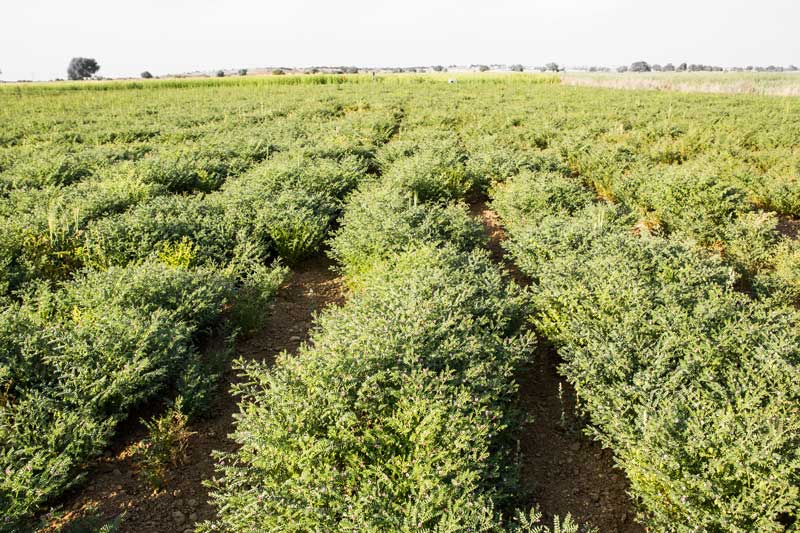
A field of gram crop in Masurdi Khadin
Gram is another commonly sown cash crop when the monsoon rainfall is scant. It is sown especially in khadin fields where the soil is coarser. Of the three crops – wheat, mustard and gram, the water requirement of gram is the least, and hence during the rabi season of 2017-2018 when the rainfall was comparatively low, many khadin fields were sown with gram, including those in Masurdi Khadin as shown in the photo above. The average yield of gram is 15-25 quintals per hectare and only a small part is retained for domestic consumption, most of it being sold in the market. During the rabi season of 2017-2018, gram fetched a price of about 4,000 Indian Rupees per quintal (approx. 54 USD).
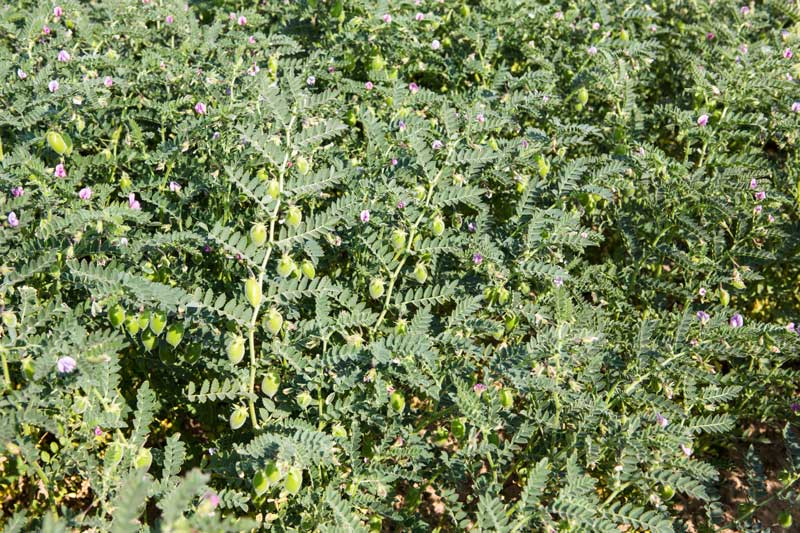
Gram crop in Masurdi Khadin
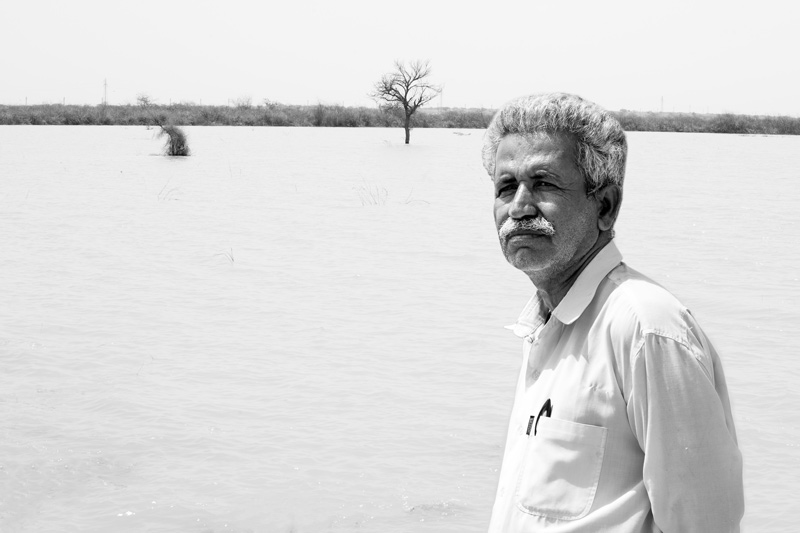
Chatar Singh explaining about water sold from Derasar Khadin
When the stored runoff in khadins is drained out, this drainage is often used for enhancing the soil moisture in fields located downstream. It may be just let out for use by farmers downstream, or sometimes sold off. In the photo above, Chatar Singh is explaining how the water from Derasar Khadin is auctioned to farmers downstream who further use it to inundate their individual fields for shorter periods, which are thereafter sown with rabi crops. In September 2017, water auctioned from Derasar fetched a price of 100,000 Indian Rupees (approx. 1,430 USD) and this money is used for maintenance of the khadin. In case of another khadin revived by Chatar Singh - Bijrasar - the outflowing water was just used by farmers to inundate their individual fields within an area of about 60 hectares which actually lies within the Indira Gandhi Canal (IGC) irrigated belt but has no water.
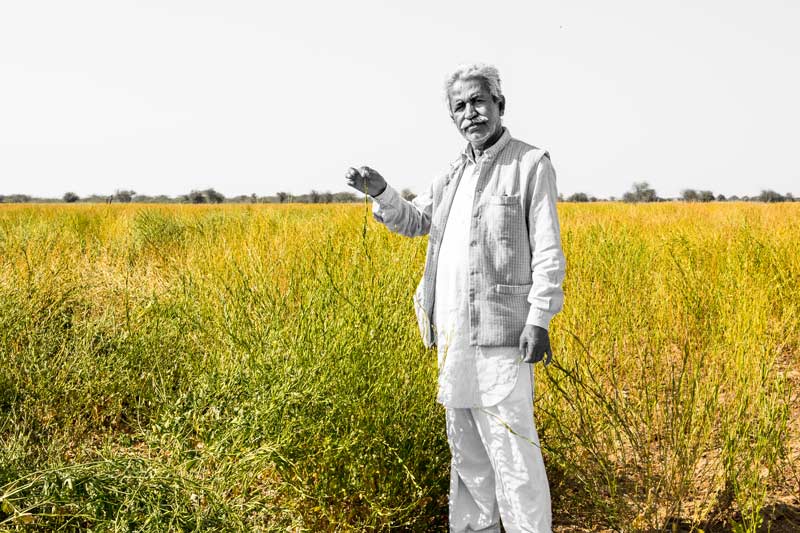
Chatar Singh showing taramira crop grown with water purchased from Derasar Khadin
Taramira is a highly drought resistant crop which grows well even under poor rainfall condition. It is a cash crop used for producing oil which is highly pungent. Apart from its use for pickling of vegetables and sometimes as a salad or cooking oil, it is used as massage oil that soothes the skin. The seed cake, a byproduct of oil production, is also of use as animal feed. Taramira is also a newly adopted crop in the region, grown in khadins , as shown in the photo above, as well as outside.
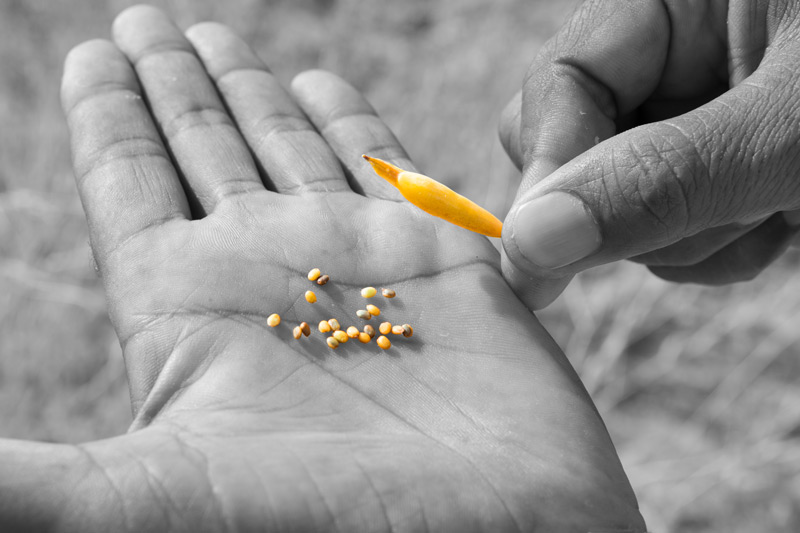
Taramira seeds grown in fields near Derasar Khadin
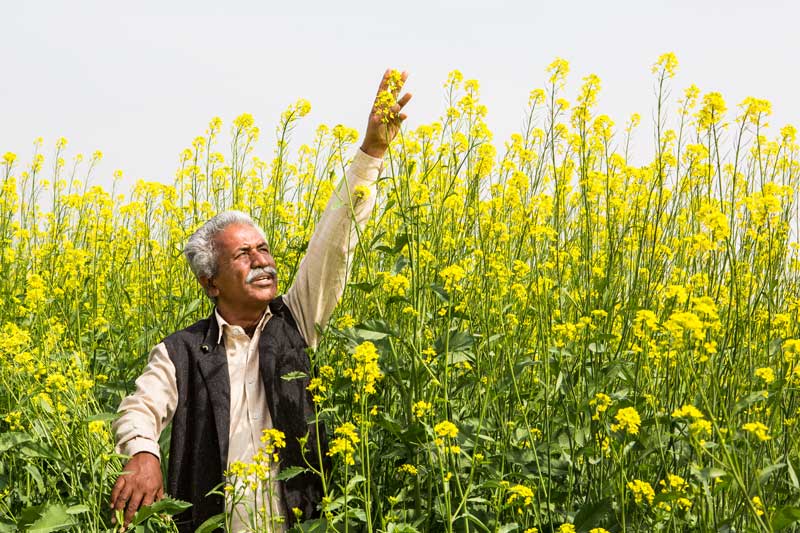
Chatar Singh proudly demonstrating the high quality and healthy mustard crop in Bijrasar Khadin
Bijrasar is a 400 year old khadin which was lying out of use for about two decades, until it was rejuvenated by Chatar Singh two years ago. During the rabi season of 2015-2016, about 50 hectares in Bijrasar was sown with mustard, leading to a yield of 500 quintals. On the following occasion, all the 80 hectares in this khadin were sown with mustard, a glimpse of which is presented in the photo above. This khadin produced about 800 quintals of mustard during the rabi season of 2017-2018, generating an income of 2,800,000 Indian Rupees (more than 40,000 USD).
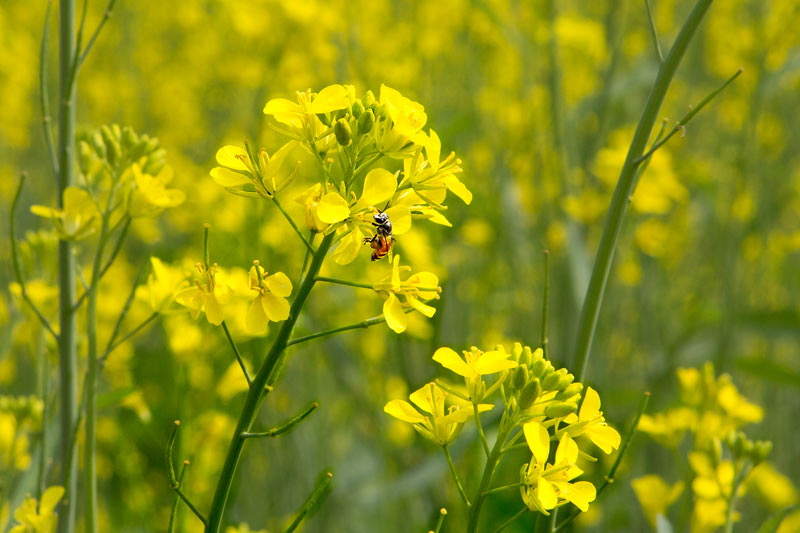
Honey bee amidst mustard flowers in Bijrasar Khadin
The mustard grown in Bijrasar Khadin is completely organic since fertilizers and pesticides are not used. According to Chatar Singh, this is attested by presence of honey bee visiting the crops, as seen in the mustard field in the photo above. It is well known that use of pesticides is a key factor underlying decline of honeybee population in nature, since chemicals contained in these compounds are toxic.
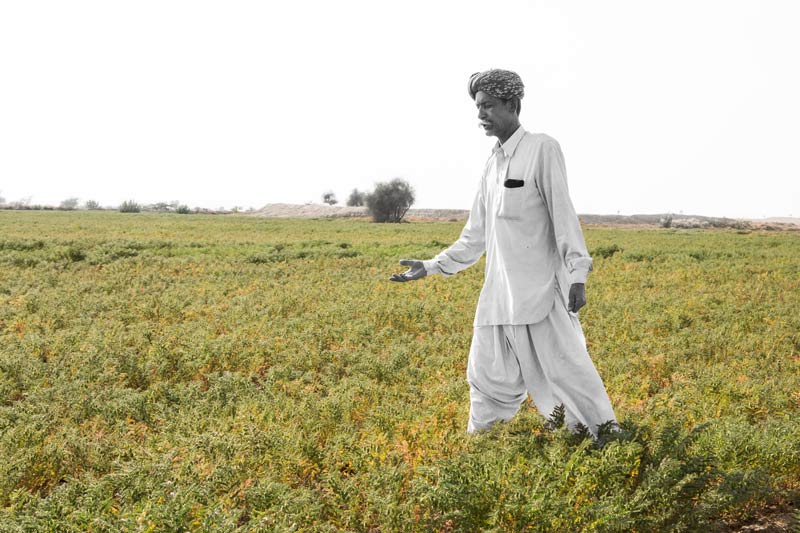
A Bhil farmer proudly displaying gram crops grown in his newly developed khadin
Considering the benefits of khadin for socio-economic development in the Thar Desert, in recent decades efforts are being made to revive the dysfunctional traditional khadins and also create new ones, the latter being smaller in size and often owned by individual farmers. One such instance are the new khadins developed for the Bhil community in Ramgarh region of Jaisalmer district. Bhils historically practiced transhumance, migrating with their flocks in search of pasture and water during the dry season. In order to help them with settled livelihoods, government allocated agricultural land to them in the 1970s, but these fields remained mostly fallow due to scarcity of water. Around 2010, Chatar Singh guided the development of 35 small khadins in a series over 150 hectares in Bhil villages like Ekalpaar and Dabbla Paar. One of the first farmers to be benefited was Gaji Ram, shown in the above photo. He owns about 12 hectares of khadin land on which he could produce gram crop worth 400,000 Indian Rupees (approx. 5700 USD) during the 2017-2018 rabi season. As a result of these interventions, the Bhil tribal communities in the above villages have been able to change from transhumance to settled lifestyles, with significant improvement in their socio-economic status.
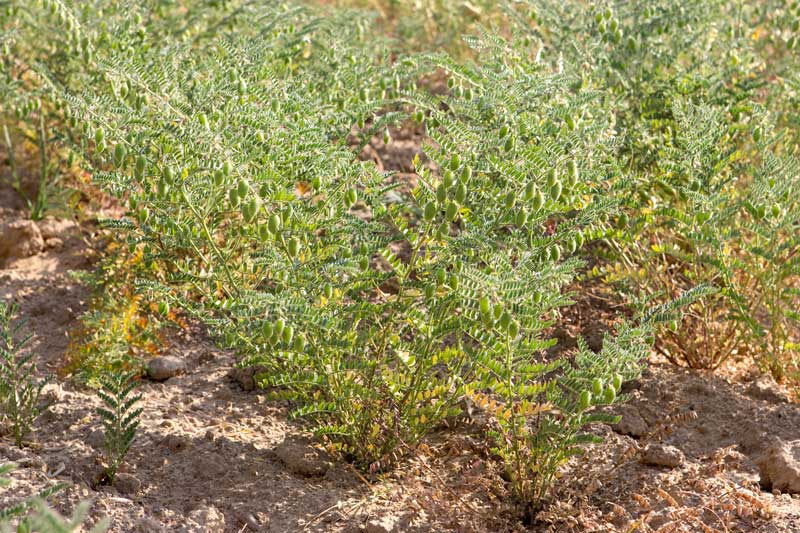
A vibrant gram crop with healthy pods in the Bhil farmer's khadin shown above
This photo story has illustrated how the nature-based solution of khadin has enabled sustainable agriculture in the heart of the Great Indian Desert through centuries. The tradition of khadin has practically led to creation of man-made oases in the desert, bringing water and food security, sustainable livelihoods and socio-economic well-being in the harshest of the eco-climatic settings where climatic variability and extreme is also significant. Rain drops of Rajasthan have been called 'silver drops' by the renowned Gandhian, environmentalist and water conservationist Anupam Mishra, and these precious drops are conserved by the farmers of the Thar Desert for agriculture through the traditional rainwater harvesting system of khadin. It is indeed a wonder how with an average annual rainfall as little as 100 mm, the farmers are able to grow crops that are suitable for cultivation under a rainfall condition ranging between 500-1000 mm, without the application of any external irrigation. The khadin system is based on perfect science where principles of rainwater harvesting have been first drawn in correlation with the existing topography and stratigraphy, next a technology for moisture-sealing in khadin fields has been designed and finally appropriate selection of crops suitable for growth within the given soil, water and climatic conditions has been made. Moreover, the technology has a built-in mechanism for enhancing soil fertility and increasing the cultivated area from one year to the next.
Evaluations of khadin-based farming have shown that their production is no less in terms of quality or quantity, compared to conventional irrigation practices, rather the quality is superior because it is raised with only rainwater, without the use of any fertilizer. Even the use of pesticide is rare. As stated before about one-fourth of the years in a decade in the Thar Desert are drought-affected, but khadin farming brings climate resilience, making the impact of drought almost negligible for the local communities. Through a single-season (rabi) cropping, the farmers are able to grow much, store enough for domestic consumption, and sell the surplus for cash, which helps sustain their lives and economies through the drought period. Moreover, fodder stocks are created for their animals and even drinking water availability is enhanced through khadin-based shallow wells, which are used for humans as well as animals during the dry periods. There is no doubt that the nature-based solution of khadin helps secure people's human rights to water, food, health, livelihoods, and development. It also offers a good model for climate resilience since it brings protection against drought as well as flood which can be a substantial risk in the desert, as the speed of the run-off gets checked, it is allowed cascading space in the fields to settle down, followed by infiltration underground which produces long-term water treasure. It undoubtedly enables integrated development of the local desert communities considering all the three dimensions of sustainability - social, economic and ecological, thereby even supporting several of the Sustainable Development Goals (SDGs). Realizing the value of khadins in the desert environment, the government has implemented programs for renovation of the old khadins and preparation of new ones under different programs. Even some non-governmental organizations have been active in this direction and individual efforts such as that by Chatar Singh are commendable. Chatar Singh has helped renovate three large traditional khadins and created about 50 new ones, on the whole bringing over 1000 hectares of khadin land under cultivation in Ramgarh region of Jaisalmer district.